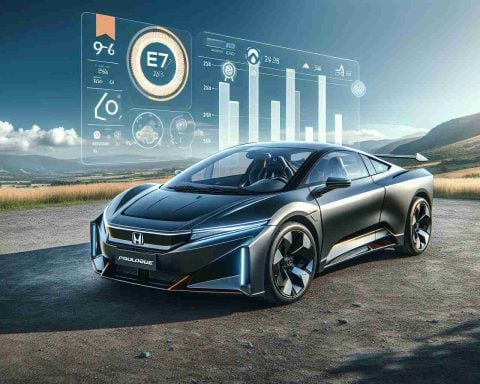- Mr. Deng’s ambition to drive the Li Auto L9 globally highlights challenges for Chinese electric vehicles entering international markets.
- The journey encounters problems when a sea transport company demands documentation for safety and hazardous materials from Li Auto, which restricts the car’s use to mainland China.
- Promotional materials and vlogger experiences suggest international capability of the L9, but regulatory hurdles complicate overseas usage.
- Batteries linked to a company scrutinized by the U.S. Department of Defense hinder the L9’s entry into the U.S. market.
- Reports of software glitches and AI misjudgments highlight ongoing safety and technological concerns in the industry.
- The narrative underscores the tension between innovation and regulatory compliance faced by the electric vehicle sector globally.
A bold vision fuels Mr. Deng from Guangdong: a global road trip in his sleek 2023 Li Auto L9, a symbol of Chinese ingenuity in electric vehicles. Yet, as he embarks on this venture, his aspirations hit an unexpected roadblock. The possibility of setting tire upon foreign roads spirals into a bureaucratic nightmare.
The odyssey begins with a catch—a sea transport company insists on documents that seem elusive. As Mr. Deng reaches out to Li Auto, seeking the essential safety data sheets and hazardous material certificates for his electric dream machine, a curt response echoes back: “The car is for use only within mainland China.”
Conflicting signals emerge when Mr. Deng uncovers promotional material depicting the L9 cruising down Los Angeles streets. Even more perplexing, online clips showcase intrepid vloggers effortlessly navigating foreign terrains in the very same model.
Yet, behind these glossy portrayals lies a complex maze. The L9 harbors batteries from a company recently spotlighted by the U.S. Department of Defense for alleged ties to the Chinese military, complicating any attempt to cross American shores. This listing casts long shadows, chilling ambitions just as they begin to thaw.
Moreover, narratives of spontaneous software updates and startling misjudgments by the car’s AI evoke both technological wonder and trepidation—prompting a debate about the rapid ascent of electric vehicles and the overlooked nuances of safety.
The tale of Mr. Deng, therefore, unfolds as an emblem of the broader industry at a crossroads, where progress races against the minutiae of global compliance and consumer assurance. For now, the dream of a borderless electric journey remains a challenging frontier.
Unlocking the Future: The Cross-Border Challenges of the Li Auto L9
How-To Steps & Life Hacks: Preparing Your Electric Vehicle for International Travel
Traveling internationally in an electric vehicle (EV) like the Li Auto L9 requires specific steps to ensure a smooth journey:
1. Research Import Regulations: Before beginning the journey, familiarize yourself with the import and transport regulations of the destination country. Regulations can vary significantly and may affect whether you can legally drive your EV there.
2. Acquire Necessary Documentation: Gather all required documents such as safety data sheets, certificates of origin, and proof of conformity with local emissions and safety standards.
3. Insurance and Licensing: Ensure you have international car insurance coverage and an international driver’s license, if necessary.
4. Plan Charging Stops: Map out your route to include available EV charging stations. Apps like PlugShare can be invaluable resources for finding charging locations.
5. Understand Local Road Laws: Study the driving laws of the countries you plan to visit. This includes understanding road signs, speed limits, and right-of-way rules.
Real-World Use Cases: The Potential of Electric Vehicles in Global Travel
Although Mr. Deng’s experience highlights the challenges, there are compelling examples of EVs successfully traversing international borders. For instance:
– Promoting Green Tourism: EV road trips can form part of sustainable tourism initiatives, encouraging eco-friendly travel.
– Showcasing Innovation: Long-distance travel in an EV can serve as a demonstration of technological advancements and reliability in various terrains and climates.
Market Forecasts & Industry Trends
The electric vehicle industry is rapidly evolving, with global EV sales projected to exceed 31 million units by 2030, according to BloombergNEF. The push for sustainability is driving innovation, and China is expected to remain a dominant player in the EV market due to governmental support and domestic demand.
Reviews & Comparisons: Li Auto L9 vs. Competitors
In terms of features, the Li Auto L9 competes with other luxury EVs like the Tesla Model X and NIO ES8. Each offers distinctive advantages:
– Li Auto L9: Notable for its hybrid-electric powertrain and spacious design, catering predominantly to the Chinese market.
– Tesla Model X: Renowned for extensive charging network access and sophisticated Autopilot technology.
– NIO ES8: A full-size, all-electric SUV known for its battery-swap technology.
Controversies & Limitations
– Supplier Allegiances: The L9’s battery supplier has been flagged by the U.S. Department of Defense for potential ties to the Chinese military, complicating entry into certain markets.
– Software Reliability: Concerns are rising over the security and dependability of over-the-air software updates, after reports of unexpected AI misjudgments.
Features, Specs & Pricing
– Pricing: The Li Auto L9 is priced competitively for a luxury hybrid SUV, although exact figures may vary with local taxes and shipping costs.
– Features: Includes a panoramic sunroof, advanced driver-assistance systems, and a dual-motor hybrid system designed to extend range and performance.
Security & Sustainability
EVs like the L9 play a pivotal role in the move towards sustainability by offering lower emissions and enhanced fuel efficiency. However, the sourcing of batteries and minerals continues to pose environmental and ethical challenges.
Insights & Predictions: Future of EVs and Global Policy
As governments worldwide push for stricter emissions regulations, international policies are likely to become more accommodating for EV travelers. Broader acceptance and standardization of EV infrastructure will play a crucial role in this shift.
Pros & Cons Overview
Pros:
– Eco-friendly and energy-efficient.
– Luxurious features with advanced technology.
Cons:
– Limited international support and infrastructure.
– Current geopolitical tensions may hinder market entry and acceptance.
Actionable Recommendations
– Plan Ahead: For those looking to travel internationally with an EV, meticulous planning and legal compliance are crucial.
– Stay Informed: Keep track of emerging regulations and diplomatic developments that might affect travel routes.
– Leverage Technology: Use apps and online resources to stay aware of charging stations and route conditions.
For more information on the ever-evolving electric vehicle landscape, visit Bloomberg and PlugShare for charging station locations worldwide.

















